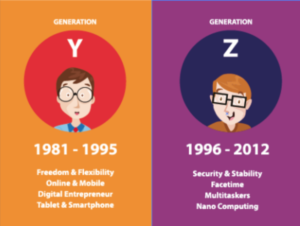TEST
Gen Z = $44 Billion Buying Power (let that sink in)

If you asked me to list all the different characteristics of each of the various generations we often mention in our research, I would say to you I’ve lost track. In fact, I’ve lost track of all the X, Y’s, and Z labels that are attributed to each. However, when I recently saw a statistic that noted that Generation Z will account for 1/3 of the U.S. population by 2020, and will also have the largest buying power with $44 billion in the U.S. economy- well, the marketer in me started to pay attention.
Now, let’s not confuse Gen Z with what we know as a “millennial.” So we’re clear, there are some similarities, but the differences are just as vital. Gen Z are those that were born after 1997. This generation doesn’t know a time without smartphones and advanced technology. Many Millennials, in contrast, experienced the transition from flip phones to the first smartphone, to the introduction of internet and evolution from dial-up to wifi, etc. Additionally, according to Sustainabilitynext.com (2017):
-94% of Gen Z believes companies should help address social and environmental issues (vs. 87% – Millennial, 86% General Population)
-89% would rather buy from a company supporting social and environmental issues over one that does not, but just 65% pay attention to company’s CSR efforts when deciding what to buy
-81% believe they can have an impact on social or environmental issues by using social media
But this blog post isn’t to only dissect the differences between the two generational groups (but if you’re interested, I’ve plugged some links below). The intent is to understand Gen Z and how to market to them, and Forbes gives us 5 ways we can successfully do that. Reminder: Gen Z= youngest generation with 44 billion dollar buying power. Let that sink in.

Understanding how to market a brand to this influential generation is critical for anyone in business. According to Wertz (2018) from Forbes Magazine, Gen Z is a demographic often overlooked by companies in their marketing plans as their focus is usually millennials. Known as the “post-millennials, and the “i-Generation”- Gen Z is perceived as a “kids” cohort that has about 66% of them glued to their smartphones. Therefore, tailoring your message for mobile and desktops with seamless integration in high profile social platforms such as Instagram and snapchat are key (Wertz, 2018). According to Forbes, Gen Z also is intrigued by personalized experiences. This personalization and customized experience in the brand messaging will build a bridge between the Gen Z consumer and the company brand.

Furthermore, Gen Z is used to an extensive portfolio of buying options, and therefore value quality over everything. Gen Z is consciously aware of making sure the money spent stretches further on a quality product. One of the contrasting facts learned from the article is that Gen Z prefers to buy in brick and mortar stores versus online. Though this may change as the generation has access to more resources such as credit cards and higher income as they grow older, synergizing efforts in the online store space along with the in-store space will keep the Gen Z cohort engage. This could be running a short spot in Snapchat on Instagram stories with an in-store redeemable coupon that results in a call to action. And finally, build trust through content. With an average of 23 hours of video content that Gen Z streams per week, it is critical that brands remain authentic and build trust with this younger audience. As Wertz (2018) stated perfectly: “if your brand doesn’t have a viable presence across Instagram, YouTube and other social media platforms, in the eyes of Gen Z, your brand doesn’t exist. It’s just that simple.”
References:
Links to Millennials vs Gen Z:





3 Responses to Gen Z = $44 Billion Buying Power (let that sink in)